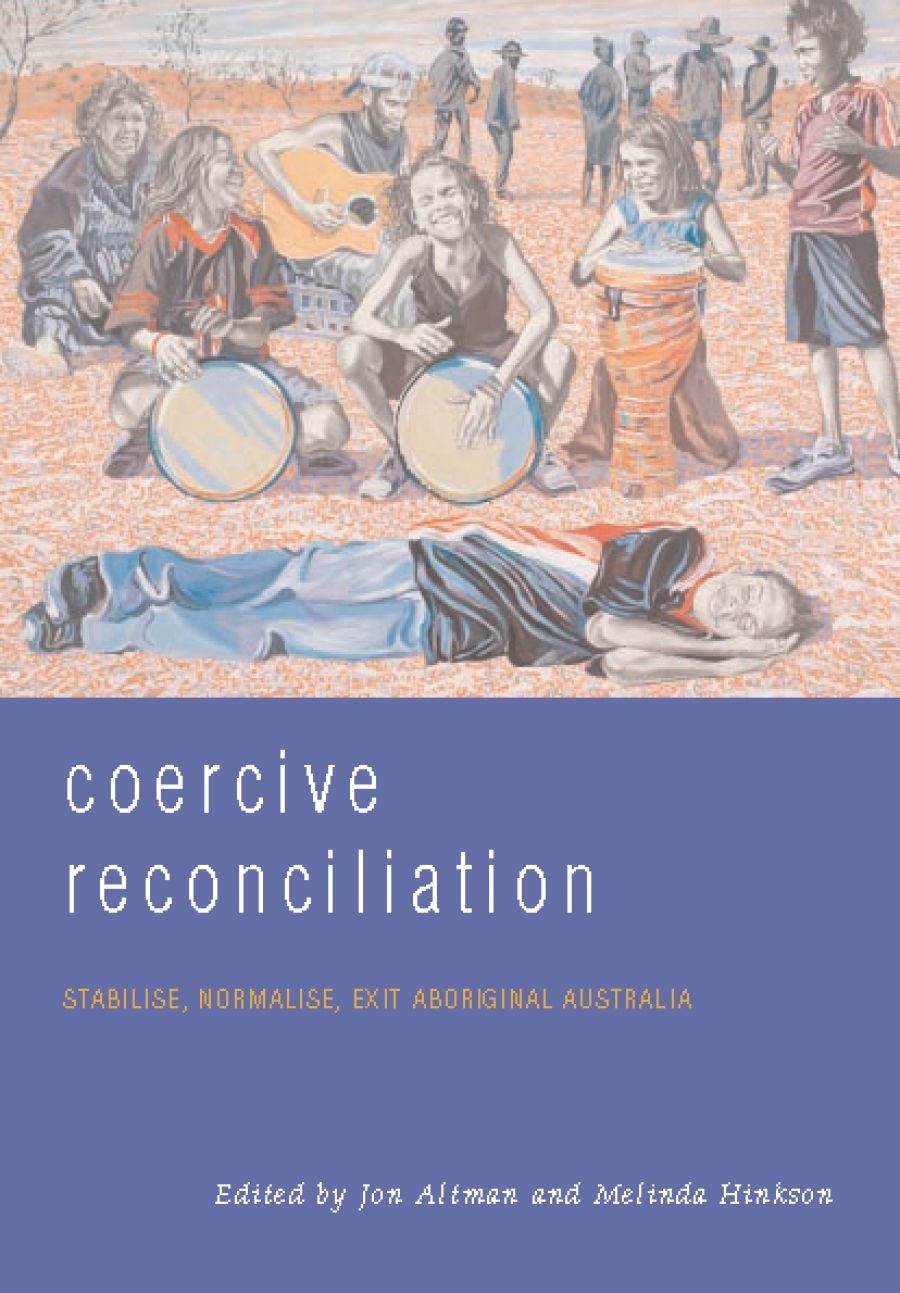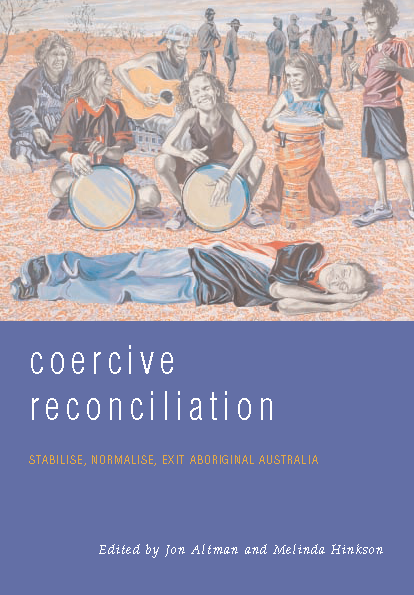
- Free Article: No
- Contents Category: Indigenous Studies
- Review Article: Yes
- Article Title: In the name of the child
- Online Only: No
- Custom Highlight Text:
A remarkable feature of this book is that its thirty essays were commissioned, written, edited and printed for distribution within four months of the Howard government’s declaration on 21 June 2007 of an emergency in the Northern Territory. Seldom can there have been such a rapid and comprehensive set of responses to a major federal government policy initiative, bearing as it did all the signs of political opportunism in its timing. By contrast with the massive legislation embodying the reforms, most of the essays are thoughtfully cast and well written: a good advertisement for the way deadlines can concentrate the academic mind. The ironic twist is that the contributors’ principal target now is the Rudd government, whose own political opportunism in Opposition ensured bipartisan support for John Howard and Mal Brough during the legislation’s scandalously brief parliamentary consideration. Significantly, Minister Jenny Macklin’s actions so far suggest that she is in sympathy with the book’s main thrust.
- Book 1 Title: Coercive Reconciliation
- Book 1 Subtitle: Stabilise, normalise, exit Aboriginal Australia
- Book 1 Biblio: Arena Publications, $27.50 pb, 341 pp
- Book 1 Cover Small (400 x 600):

- Book 1 Cover (800 x 1200):

As the title of the book suggests, its argument is that the military-style measures now being implemented in the Northern Territory effectively abandon the notion of Aboriginal reconciliation and pave a neo-assimilationist path towards the final demise of Aboriginal culture as a distinctive entity in Australian society. Seen by Daisy Bates and her contemporaries in the 1930s as a race and culture poised on the edge of extinction, subsequent Aboriginal demographic and cultural revival (in northern Australia, in particular) has long been regretted by those Australians who believe that nation-building requires racial and cultural homogeneity. How opportune it was, then, that the Northern Territory Government’s ‘Little Children Are Sacred’ report of mid-June 2007 should have painted such a horrific picture of child (and infant) sexual abuse and of domestic violence, strengthening the Hansonist view of traditional Aboriginal culture as not only savage but deeply depraved. Confronted with this highly disturbing picture of dysfunctional communities and their helpless child and women victims, the Australian public was well conditioned to accept a parcel of measures which had as much to do with unravelling the few progressive measures of the last three decades as with countering domestic violence and child abuse. Something had to be done in such an emergency, most people agreed. The lack of discussion and consultation with Aboriginal people went virtually unnoticed in the brief moral panic. It was an opportunity that the neo-assimilationists greeted as a godsend, prompting Patrick Dodson to prophesy that ‘[t]he extinguishing of indigenous culture by attrition is the political goal of the Howard Government’s indigenous policy agenda’.
Ideologically, the policy has its roots in the assimilationist principles and practice of Paul Hasluck as federal minister for territories in the early 1950s. Enlightened as Hasluck was in the area of legal equality and access to education and other social services, his emphasis on the Aboriginal individual’s making his or her own way up the ladder of capitalist society betrayed an unawareness of the communal nature of Aboriginal social organisation, particularly in northern Australia. He also believed in the inevitability of race and culture extinction in the medium term.
The task of Coercive Reconciliation is to reveal that revived agenda and to explore its likely outcomes if implemented in its current legislative form, at the same time reasserting the contributors’ favoured model of reconciliation and suggesting how that project can be constructively advanced. Thus we have a dialectic between two totally opposed views of the future: an Australia in which Aboriginal people in northern Australia (most of them living in remote communities) will be integrated as individuals into the national market economy and then assimilated into mainstream Australian society; and an Australia in which Aboriginal groups, afforded ‘First Nation’ status in a rewritten federal constitution, will maintain their cultural uniqueness and communal integrity within a hybrid, part-subsidised sub-economy (in northern Australia, at least).
I emphasise northern Australia, Charles Rowley’s ‘colonial Australia’, because this is where the ideological contest is focused. Assimilation, both natural and policy-driven, has meant that Aborigines in Rowley’s ‘settled Australia’ have been largely dispossessed of the traditional lands that give their more fortunate northern cousins a clear cultural identity and the capacity for some degree of group autonomy or self-determination.
The book’s contributors do not deny that child abuse and domestic violence in northern Australia have reached epidemic proportions, or that rapid and drastic action is essential. They support the provision of more police in remote communities and the extension of the existing Northern Territory system of health-checks on children. They agree that there is a crisis in housing. The targets of their criticism are the radical changes to land tenure, the abolition of the permit system and dilution of Aboriginal governance, together with the abolition of the CDEP scheme on which the present hybrid Aboriginal sub-economy depends, changes which are not related to child abuse. All these they see as being made in order to bring individual Aboriginal people in remote settlements into the market economy of northern towns, or what Noel Pearson calls the ‘real’ economy. Pearson himself is credited (or, rather, blamed) for doing much to galvanise public support for the Howard–Brough initiative, although it is also pointed out that his Cape York project is cushioned by federal government financial assistance against the hard bumps of the market. Pearson’s main influence seems to be the principle of ‘quarantining’ (sequestering) welfare payments, an important issue upon which the book’s contributors remain notably silent. A much more potent influence on the initiative is the writing of conservative economist Helen Hughes, which is robustly critiqued by Tim Rowse and Jon Altman in their essays.
The vexed question of Aboriginal governance has been with us from the British occupation of Australia: from Governor Lachlan Macquarie’s vain attempt to institute a system of Aboriginal ‘constables’ in place of non-existent ‘chiefs’, to the demise of ATSIC. Governors and governments have bewailed the absence of a recognisable indigenous leadership structure with which they could negotiate (never on equal terms, needless to say) and utilise in a system of indirect rule. At the moment, Minister Macklin’s abolition of ATSIC’s purely advisory successor means that, for the time being, there are no officially acknowledged Aboriginal voices at a national level. Nevertheless, as Rowse highlights in what is perhaps the book’s most optimistic essay, Aboriginal organisations in the Northern Territory (including the two land councils) have enjoyed a fair degree of success and support. This signals the corporate capacity of self-government that he regards as one of the four basic elements constituting a ‘jurisdiction’. Finally, Rowse observes that ‘the project of self-determination requires a continuing critique of two traditions, not one’.
The essential question is whether there is the political will in Australia to pursue the reconciliation model. In his opaque but at times provocative essay, the philosopher Raimond Gaita warns us that we must not depend on the rights-based approach to Aboriginal issues that some of his fellow-contributors hold. ‘The spirit of justice’ within white Australian society offers the only basis for change, he insists, citing Simone Weil’s ‘impulse of charity on both sides’. Likewise, Pat Dodson reflects that ‘Unless the engagement and dialogue between us is premised on the concept of “the listening heart”, then our relationship will remain out of balance and our endeavours will be doomed’. Whether this amounts to anything more than whistling in the wind will be decided by a new generation of Australians.
One serious problem with the book is that it features thirteen essentially harmonious Aboriginal voices at a time when the divide in authoritative Aboriginal opinion on the Northern Territory initiative is becoming more marked and rancorous by the minute. Minister Macklin’s move to retain the permit system (in line with the book’s recommendations) has been roundly criticised by Marcia Langton and Warren Mundine and ignores the powerful message of playwright Louis Nowra’s book Bad Dreaming: Aboriginal Men’s Violence against Women and Children (2007), which documents the way in which the system has helped Aboriginal men (not just in northern Australia) to get away with domestic abuse, rape and even murder. (‘The permit system is used to hide the truth and protect the men’.) There is a real danger that just as the ‘history wars’ were essentially a white historians’ debate about the nature of settler society in which the Aboriginal present was irrelevant, so the current ideological tussle over policy will take the focus away from the dreadful plight of powerless Aboriginal women and children in dysfunctional communities. We must be mindful of Pearson’s reflection on the prospect of a Rudd government on the eve of the elections: ‘If you harbour any hope that these buggers are going to do anything courageous in relation to Indigenous affairs, then you’re living in an illusion.’


Comments powered by CComment